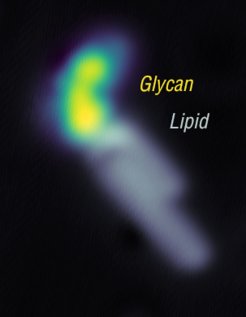A new tool to read the secret language of cells
Did you know that cells have their own secret language ... on their surfaces?
One of the ways cells communicate is by bumping to one another. This seemingly simple event triggers a cascade of molecular interactions, shaping our health, immunity, and even our response to diseases like HIV and COVID-19. Teaming up with collaborators from the University of Oxford, the University of Tübingen, and the University of Copenhagen, scientists at the Max Planck Institute for Solid State Research have developed a new method to visualize the molecules that mediate the secret conversations between cells.
These molecules are glycans (or carbohydrates) attached to proteins and lipids – and we have developed a method to visualize them at the single molecule level, allowing their structures to be analyzed one-molecule-at-a-time.
These glycan-decorated proteins (or glycoproteins) and glycan-decorated lipids (or glycolipids) which are found abundantly on cell surfaces are considered the ‘language’ of cells. With many important biological roles, they are essential for the survival of living organism. Yet, despite their importance, figuring out what glycoproteins and glycolipids are present on a cell surface remains an extremely challenging task for today’s analytical technology.
Why care? Figuring out glycoprotein and glycolipid structures are very important for the development of new vaccines and medicines, and for an understanding of how cells communicate and how diseases progress. For example, key proteins involved in HIV or SARS-Cov2 infection are densely covered with glycans that enable them to escape neutralization by our immune systems.


To address the analytical gap in this problem, in our work, we directly image single glycoproteins and glycolipids by scanning tunnelling microscopy (STM) at cryogenic temperatures.
To accomplish this, glycoproteins and glycolipids dissolved in solutions are brought to the gas-phase as ions, soft landed at a surface, and imaged by STM at single molecule level. STM allows non-destructive, direct visualization of the molecules, revealing their structures one-molecule-at-a-time. In STM, an image of the nanoscale world is obtained by scanning a sharp metallic tip over a surface and measuring the amount of electric current that flows between the tip and the surface due to electron tunnelling.
We show that STM imaging allows glycoproteins and glycolipids to be analyzed at single molecule level. STM imaging reveals not only the site where the glycan connects to its host molecule, but also the structure of every glycan connected to the host, thus providing structural information that remains inaccessible by the present technology.
To show the perspective of our techniques, we image a wide range of glycan-decorated molecules, such as GM3 and GD3 glycan-decorated lipids, and MUC1 glycan-decorated proteins – all of which are known to be present in cancer cells. Our technique provides a new tool to visualize structures of many glycan-decorated molecules, such as the sugar coating on bacteria as well as on human cells, that are so far intractable by present techniques. This allows ‘the sugar code’ to be read directly for the first time.
Kelvin Anggara












